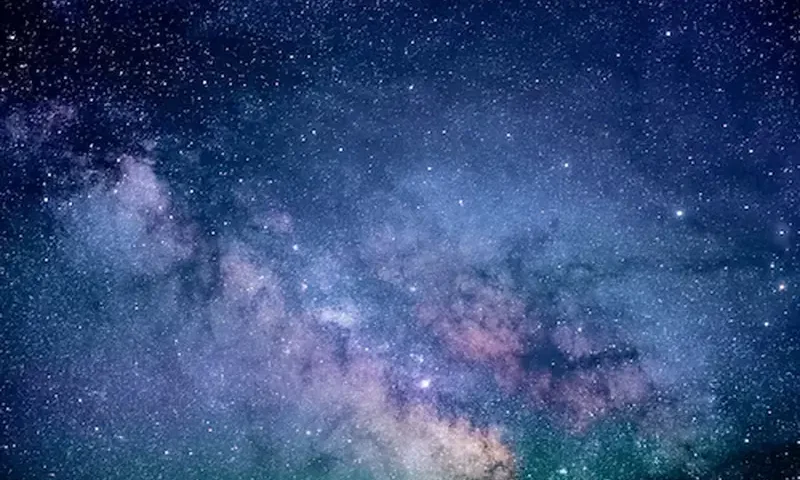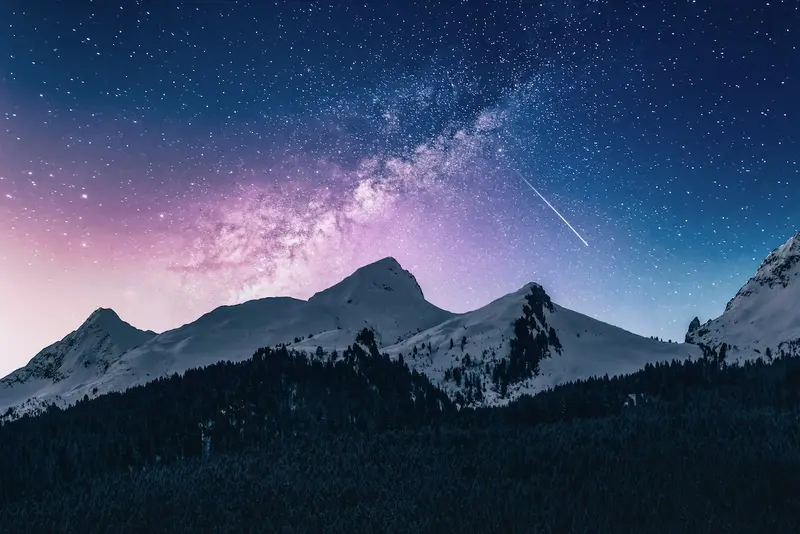Milky Way – What is our galaxy relative to the Universe?

Find the perfect car – a practical guide to choosing a vehicle
16 June 2023
Speed of Light – Unattainable speed
18 July 2023
Narodziny Drogi Mlecznej - Czym jest nasza galaktyka względem Wszechświata? Zdjęcie: unsplash.com
When you suddenly turn off the lights in a big city and look up at the sky, you see endless fields of stars forming a shape similar to a smeared milk path. This is the Milky Way – our cosmic home. But how did such a huge structure come to be? What is the Milky Way in the context of the unimaginably vast Universe?
Spis treści:
ToggleIntroduction
Our galaxy – the Milky Way – is like an enchanted cosmic theater, on whose stage an unimaginable number of stories are played out. Each star, each planet, each cloud of dust and gas has its own unique story, which over billions of years has contributed to the formation of this cosmic landscape we see today. But what do we really know about the Milky Way? How did it get its name, how was it formed, what does it contain, what are its closest neighboring galaxies, and what awaits us in the future?
The adventure we’ll take you on in this article begins with the origins of the Universe, travels through cosmic nebulae and stellar currents to our current understanding of the Milky Way and its place in the vast cosmic ocean. Along the way, we will answer some of the most fascinating questions about our galaxy and understand how all of this affects our understanding of Earth’s place in the Universe.
Given the enormous range of topics to be covered, the most important thing to remember is that the Milky Way is more than just a collection of stars and planets – it is our cosmic home, our place in the Universe, which we are still discovering and trying to understand. Knowing about it is therefore not only a matter of scientific curiosity, but also a way to better understand ourselves and our place in the Universe.
The birth of the Milky Way
The Milky Way, our home galaxy, was born about 13.6 billion years ago, shortly after the Big Bang. At first it was just a huge cloud of gas and dust, which, under the influence of gravity, began to curl up and form into a rotating spiral structure. This process took billions of years, and the stars we see today were formed through a process of continuous formation and death of previous generations of stars.
Description of the Milky Way
Our galaxy, the Milky Way, is a beautiful and dynamic structure whose size and complex shapes exceed human imagination. It consists of billions of stars, planets, clouds of gas and dust, which together form a complex and fascinating structure.
Form and Structure
The Milky Way has the shape of a flat disk with a distinct boulevard in the center and spiral arms that diverge from it. This form is typical of spiral galaxies. Our galactic disk is about 100,000 light-years in diameter and is about 1,000 light-years wide.
At the center of the galaxy is a boulevard where the oldest stars of the Milky Way are concentrated. It is surrounded by a disk that contains younger stars, dust, gas and spiral belts. The spiral belt where our Sun is located is called Orion’s Arm.
Surrounding the disk and the boulevard is the so-called halo – a huge sphere containing globular clusters (clusters of old stars) and dark matter, the presence of which we can infer only from its gravitational influence on surrounding objects.
Stars, Planets and Dark Matter
There are between 100 and 400 billion stars in our galaxy, including our Sun. Some of them are young and hot, shining with bright white light, while others are older and cooler, through to shine with red light. There are also estimated to be billions of planets in the Milky Way.
The Milky Way also contains significant amounts of dark matter. This is a form of matter that we cannot observe directly, since it neither emits nor absorbs light. However, its presence can be detected through its gravitational influence on visible objects.
Earth’s place
Our Sun, along with Earth and the other planets in our solar system, is located on one of the smaller spiral arms, the Orion Arm, about 26,000 light-years from the galactic center.
In summary, the Milky Way is a true cosmic marvel – a complex, dynamic and beautiful structure, the study of which allows us to better understand the nature of the Universe.
What is the Milky Way in space?
When we look at the night sky, we see only a fraction of this galactic structure in which we live. The Milky Way, as seen from Earth, appears to be just a delicate streak of light cutting through the dark sky. However, it is a mere shadow of the reality that is our galaxy.
The Milky Way is a huge, flat spiral structure, consisting of about 100-400 billion stars, and its diameter is about 100,000 light years. This type of galaxy, like ours, is often referred to as a spiral galaxy with a crossbar, due to its characteristic „S” shaped structure with a distinct belt of stars crossing its center.
The Milky Way’s nucleus, called the boulevard, contains the oldest stars in the galaxy. It is surrounded by the galactic disk, which contains younger stars, dust, gas and spiral belts. The galactic disk is where new stars form. Surrounding the disk and the boulevard is a halo – a sphere of old star clusters and mysterious dark matter that cannot be seen, but whose presence can be detected by gravitational effects.
We are located on one of the spiral arms, about 26,000 light years from the galactic center. Looking at our galaxy from the outside, one would be able to see the spiral structure, in which stars and gases form fantastic patterns, curling around the center.
It is important to remember that the Milky Way is only one of billions of galaxies in the Universe. It is part of the so-called Local Group – a group of galaxies that also includes Andromeda, the Large Magellanic Cloud and the Small Magellanic Cloud. This group, in turn, is part of a larger structure known as the Local Supergroup, which consists of thousands of galaxies spanning about 100 million light-years.
Thus, although the Milky Way is our cosmic home, it is only one of countless „homes” in the infinite ocean of the Universe.

How many and what planets are in the Milky Way?
Although our knowledge of the Universe is limited, astronomers estimate that there are at least as many planets as stars in our galaxy, the Milky Way. Given that the number of stars in the Milky Way is estimated to be between 100 and 400 billion, it is possible that there are at least as many planets, if not more.
The planets in our galaxy are extremely diverse in size, composition and surface conditions. They range from small, rocky Earth-like planets to huge Jupiter-like gas giants. There are also planets with extreme conditions, such as hot, lava-covered planets, planets with extremely high temperatures, but also those that are unimaginably cold, and even starless planets that drift alone through dark space.
These planets orbit different types of stars, from hot, young stars that emit blue light, to cooler, older stars that shine with red light. Some of these planets are likely inhabited by life forms, although we have no evidence of this at this time.
The size and diversity of the Milky Way suggests that there are many undiscovered planets waiting to be discovered. Missions such as NASA’s Kepler and TESS (Transiting Exoplanet Survey Satellite) have already discovered thousands of exoplanets (planets outside our solar system) and have contributed to our understanding of how diverse the planets in our galaxy can be.
So, although we can’t tell exactly how many planets are in the Milky Way, we can say with certainty that there are many, and their diversity is beyond our wildest imagination.
Our neighboring galaxies
The Milky Way is not a solitary galaxy. It is part of the so-called Local Group, which includes some 54 galaxies, including Andromeda, the Large Magellanic Cloud and the Small Magellanic Cloud.
What do we know about Andromeda – the Milky Way’s closest neighbor?
Andromeda, also known as M31, is a spiral galaxy located about 2.5 million light-years from Earth. It is the closest spiral galaxy to us and the brightest galaxy in the night sky that can be seen with the naked eye under good observational conditions.
It is also one of the largest galaxies in our Local Group. Andromeda is de facto larger than the Milky Way and contains more stars – it is estimated that there may be as many as a trillion stars there, compared to 100-400 billion in our galaxy.
Andromeda, like the Milky Way, has a spiral structure, with a large belt of stars crossing its center. At its center is a supermassive black hole, much like the center of the Milky Way. Stars, gases and dust form fantastic spiral patterns that orbit around this central point.
One of the most fascinating aspects of Andromeda is its future. Current calculations and simulations suggest that Andromeda and the Milky Way are on a collision course. However, there is nothing to worry about – this cosmic collision should happen in about 4 billion years. The process will not involve direct star collisions, but rather the gradual merging and transformation of the structures of the two galaxies under the influence of gravitational forces. The end result, presumably, will be a new, larger galaxy.
The study of Andromeda provides valuable information about the evolution of galaxies and the nature of the Universe. Because it is so close, it makes an excellent object for observation and analysis, helping astronomers better understand how galaxies, including our own Milky Way, formed and evolved.
Summary
The Milky Way, our cosmic home, is an extremely complex and fascinating structure. It is a huge spiral galaxy, consisting of hundreds of billions of stars and probably at least the same number of planets. It is home to our Sun and Earth, as well as many other fascinating astronomical objects.
The example of Andromeda, our closest galaxy, shows us that we are not alone in space. There are thousands, if not millions, of other galaxies, each with its own unique set of stars, planets and other objects. These galaxies, like our own, are part of an ever-growing, dynamic Universe.
Studies of the Milky Way and other galaxies are crucial to understanding our place in the Universe. Through them, we can learn more about the history and future of our galaxy, the evolution of stars and planets, and even the possibility of life beyond Earth.
However, despite tremendous advances in our knowledge, many mysteries remain unexplained. Exactly how many planets are there in the Milky Way? Could life exist on any of them? What will happen when the Milky Way collides with Andromeda? These and many other questions are waiting to be discovered by curious and ambitious space explorers. This reminds us how little we know about our extraordinary Universe, and how much remains to be discovered.
Frequently asked questions
How old is the Milky Way?
The Milky Way is about 13.6 billion years old.
How big is the Milky Way?
The Milky Way is about 100,000 light years in diameter.
What galaxy is the Earth in?
Earth is located in the Milky Way Galaxy.
How old is the Earth?
The Earth is about 4.54 billion years old.
Is the universe expanding?
Yes, the universe has been constantly expanding since the Big Bang.
Are we alone in the universe?
This question remains unanswered. We are looking for evidence of life beyond Earth, but so far we have not found definitive proof.
Joanna Pera
Related articles:

The Best Bathroom Pod Manufacturer in the UK, photo by Pexels

Prędkość Światła - Nieosiągalne tempo. Zdjęcie: unsplash.com


